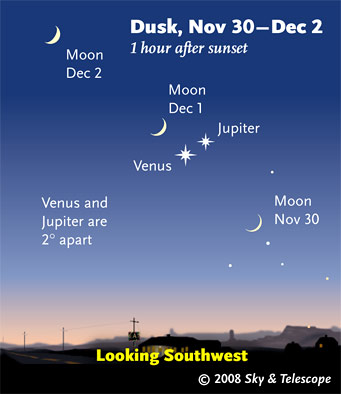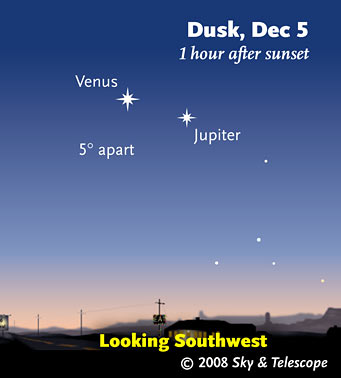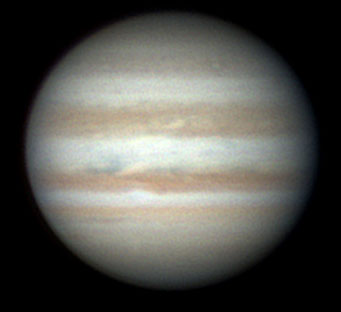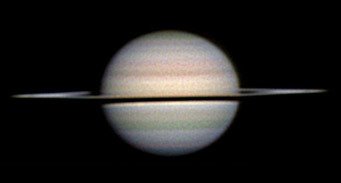"Rational and innocent entertainment of the highest kind."
— John Mills, 19th century Scottish manufacturer and founder of Mills Observatory, on amateur astronomy.
Some daily events in the changing sky for November 29 – December 6.

Don't miss the best naked-eye sky spectacle of the year! (These scenes are always drawn for the middle of North America. European observers: move each Moon symbol a quarter of the way toward the one for the previous date. In the Far East, move the Moon symbols halfway. For clarity, the Moon is shown three times actual size.)
Sky & Telescope diagram
Friday, November 28
Saturday, November 29
Sunday, November 30
Monday, December 1
Tuesday, December 2
Wednesday, December 3
Thursday, December 4

Jupiter and Venus are now drawing apart.
Sky & Telescope diagram
Friday, December 5
Saturday, December 6
Want to become a better amateur astronomer? Learn your way around the constellations. They're the key to locating everything fainter and deeper to hunt with binoculars or a telescope. For an easy-to-use constellation guide covering the whole evening sky, use the big monthly foldout map in each issue of Sky & Telescope, the essential magazine of astronomy. Or download our free Getting Started in Astronomy booklet (which only has bimonthly maps).

The Pocket Sky Atlas plots 30,796 stars to magnitude 7.6 — which may sound like a lot, but it's still less than one per square degree on the sky. Also plotted are many hundreds of good telescopic galaxies, star clusters, and nebulae.
Sky & Telescope
Once you get a telescope, to put it to good use you'll need a detailed, large-scale sky atlas (set of maps; the standards are Sky Atlas 2000.0 or the smaller Pocket Sky Atlas) and good deep-sky guidebooks (such as Sky Atlas 2000.0 Companion by Strong and Sinnott, the even more detailed Night Sky Observer's Guide by Kepple and Sanner, or the classic Burnham's Celestial Handbook). Read how to use them effectively.
Can a computerized telescope take their place? As Terence Dickinson and Alan Dyer say in their Backyard Astronomer's Guide, "A full appreciation of the universe cannot come without developing the skills to find things in the sky and understanding how the sky works. This knowledge comes only by spending time under the stars with star maps in hand and a curious mind." Without these, they note, "the sky never becomes a friendly place."
More beginners' tips: "How to Start Right in Astronomy".
This Week's Planet Roundup

As it moves farther westward in the evening sky, Jupiter has gotten small (34 arcseconds wide this week) and low, so don't be disappointed if your scope shows very little on it. Even world-class planetary imager Christopher Go recorded only this rather fuzzy view on November 16th (at 9:43 UT).
South is up, to match the view in many telescopes. Note the white outbreak in the South Equatorial Belt near the central meridian. The CM II longitude was 277°.
Venus and Jupiter, the two brightest planets (magnitudes –4.2 and –2.0 respectively), blaze strikingly close together in the southwest in evening twilight. They reach conjunction, 2° apart, on November 30th and December 1st — when the crescent Moon joins in too, as shown above. Watch them change their configuration daily. After conjunction, Jupiter starts moving off to Venus's right and then (by week's end) lower right.
In a telescope Venus is still small (16 or 17 arcseconds wide) and gibbous (68% illuminated). Jupiter is 34″ wide but has a much lower surface brightness; being 7 times farther from the Sun, Jupiter is lit only about 1/49 as brightly.
Mercury and
Saturn (magnitude +1.1, near the hind foot of Leo) rises around midnight or 1 a.m. and shines very high in the south by dawn. Don't confuse Saturn with similarly-bright Regulus 20° (two fist-widths at arm's length) to its upper right.

Saturn's rings were tilted just 1.5° from edge-on when Christopher Go took this image on November 22, 2008. Note their very prominent shadow on Saturn's globe. South is up.
Christopher Go
A telescope will show that Saturn's rings have closed to just 1° from edge on. They'll reach a minimum of 0.8° at the end of December, then start opening again before finally closing to exactly edge-on next September.
Uranus and Neptune (magnitudes 5.8 and 7.9, respectively, in Aquarius and Capricornus) are in the south to southwest during early evening. Use our article and finder charts or the chart in the September Sky & Telescope, page 63.
Pluto is hidden in the glare of the Sun.
All descriptions that relate to your horizon or zenith — including the words up, down, right, and left — are written for the world's mid-northern latitudes. Descriptions that also depend on longitude (mainly Moon positions) are for North America. Eastern Standard Time (EST) equals Universal Time (known as UT, UTC, or GMT) minus 5 hours.
To be sure to get the current Sky at a Glance, bookmark this URL:
http://SkyandTelescope.com/observing/ataglance?1=1
If pictures fail to load, refresh the page. If they still fail to load, change the 1 at the end of this URL to any other character and try again.
 0
0
Comments
You must be logged in to post a comment.